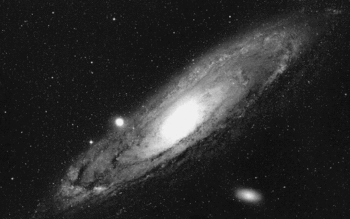Andromeda Galaxy: Difference between revisions
imported>Thomas Simmons No edit summary |
imported>Thomas Simmons |
||
| Line 32: | Line 32: | ||
===Size=== | ===Size=== | ||
Visible to the unaided eye, Andromeda appears several degrees in diameter and contains approximately 1,000,000,000,000 stars (one trillion). The Milky Way by comparison contains about 200,000,000 (two hundred billion). Conversely, new measurements employing infrared technolgy indicate that Andromeda's energy output is about that of 4,000,000,000 (four billion) suns. The most recent measurements concur with earlier estimates of the mass of the galaxy however.<ref>[http://www.nasa.gov/vision/universe/starsgalaxies/spitzer-20060605.html Andromeda Adrift in Sea of Dust in New NASA Image] NASA</ref><ref>[http://imagine.gsfc.nasa.gov/YBA/M31-velocity/M31-more.html M31 (the Andromeda Galaxy)] Goddard Space Flight Center, NASA</ref>[[Image:M31anon.gif|right|thumb|350px|{{#ifexist:Template:M31anon.gif/credit|{{M31anon.gif/credit}}<br/>|}}Andromeda Galaxy.]] | Visible to the unaided eye, Andromeda appears several degrees in diameter and contains approximately 1,000,000,000,000 stars (one trillion). The Milky Way by comparison contains about 200,000,000 (two hundred billion). Conversely, new measurements employing infrared technolgy indicate that Andromeda's energy output is about that of 4,000,000,000 (four billion) suns. The most recent measurements concur with earlier estimates of the mass of the galaxy however.<ref>[http://www.nasa.gov/vision/universe/starsgalaxies/spitzer-20060605.html Andromeda Adrift in Sea of Dust in New NASA Image] NASA</ref><ref>[http://imagine.gsfc.nasa.gov/YBA/M31-velocity/M31-more.html M31 (the Andromeda Galaxy)] Goddard Space Flight Center, NASA</ref>[[Image:M31anon.gif|right|thumb|350px|{{#ifexist:Template:M31anon.gif/credit|{{M31anon.gif/credit}}<br/>|}}Andromeda Galaxy.]] | ||
Mass of Andromeda is now calculated to be less than that of the Milky Way, at 1.23 trillion solar masses for M31, significantly less than the 1.9 trillion for the Milky Way.<ref>[http://adsabs.harvard.edu/abs/2000MNRAS.316..929E The Mass of Andromeda Galaxy] Smithsonian/NASA ADS Astronomy Abstract Service</ref><ref>[http://seds.lpl.arizona.edu/Messier/m/m031.html M31] SEDS</ref> | |||
===Age=== | ===Age=== | ||
Revision as of 18:46, 25 December 2007
Andromeda is a spiral galaxy approximately 2.5 million light years away from Earth. The furthest galaxy, by comparison, is about 13,000,000,000 (thirteen billion) light years away.[1]
| M31 | |
|---|---|
| Observation data | |
| Constellation | Andromeda |
| Right ascension | 00h42.7m |
| Declination | +41o16' |
| Distance | 2.5-2.9 million light years |
| Type | Galaxy |
| Apparent dimensions | 178.63 arc minutes |
| Diameter in ly | 250,000 |
| Apparent magnitude | 3.4 |
The largest of our nearest galactic neighbors, its disk is about 260,000 light-years in diameter. The disc of the Milky Way galaxy, our own, is considerably smaller, approximately 100,000 light years across.[2]

The galaxy is in the Andromeda Constellation. Andromeda is named for a princess in Greek mythology, the name translates "to think," "to attend to" or "be mindful of." The myth of Andromeda entails a story of a princess chained to a rock as a sacrifice to a monster. Ultimately she was saved, but the story also endows the galaxy with the appellation, "The Chained Maiden."
History
Known to Al-Sufi in Isfahan about AD 905, Charles Messier was unaware of earlier Persian records and attributed its discovery to Simon Marius, who gave a telescopic description of Andromeda in 1612.
In 1654, Giovanni Batista Hodierna discovered Andromeda without knowledge of what others had recorded long before he saw the galaxy. In 1716, Edmond Halley credited the discovery of what he then labled a "nebula" to the French astronomer Bullialdus (Ismail Bouillaud), who made his observations of Andromeda in 1661. For his part Bullialdus attributed its discovery to an anonymous astronomer 150 years prior (sometime in the early1500s).[3]
Characteristics
Andromeda has a radial or heliocentric velocity of about -300 +/- 4 km/s[4] and the Milky Way and Andromeda are approaching each other at about 100 km/sec.[5]
Size
Visible to the unaided eye, Andromeda appears several degrees in diameter and contains approximately 1,000,000,000,000 stars (one trillion). The Milky Way by comparison contains about 200,000,000 (two hundred billion). Conversely, new measurements employing infrared technolgy indicate that Andromeda's energy output is about that of 4,000,000,000 (four billion) suns. The most recent measurements concur with earlier estimates of the mass of the galaxy however.[6][7]
Mass of Andromeda is now calculated to be less than that of the Milky Way, at 1.23 trillion solar masses for M31, significantly less than the 1.9 trillion for the Milky Way.[8][9]
Age
Composition and structure
Galactic center
Spiral arms
Halo
References
- ↑ Hubble & Keck Teams Find Farthest Known Galaxy in Universe Goddard Space Flight Center, NASA
- ↑ Andromeda NASA
- ↑ Messier Object 31 Frommert, Hartmut & Kronberg, Christine (2007) Students for Exploration and Development of Space
- ↑ ANdromeda NASA IPAC Extragalactic Database
- ↑ M31 SEDS
- ↑ Andromeda Adrift in Sea of Dust in New NASA Image NASA
- ↑ M31 (the Andromeda Galaxy) Goddard Space Flight Center, NASA
- ↑ The Mass of Andromeda Galaxy Smithsonian/NASA ADS Astronomy Abstract Service
- ↑ M31 SEDS
